Palm Beach Gardening: Even in Paradise, Insects are Beautiful, too.
October 13, 2019
Palm Beach may be a paradise, but the preservation of our wonderful quality of life depends in a large part on maintaining the stunning natural beauty of our coastal environment. As stewards of our great community, it is incumbent upon us to recognize that the health of our natural environment is intricately connected to the health of our community.
We Palm Beachers have had a long love affair with our gardens and landscapes, but increasing data suggests it may be time to reconsider the chemical cost not only to our beloved barrier island, but also to ourselves. Tall hedges, pristine green lawns, and insect-free flowers may look beautiful, but these require a devastating chemical cocktail.
Almost every environmental study to date agrees that we are all eating, drinking and breathing the chemicals we apply to our plants.
On Sept 19, the journal Science released the staggering report that North America’s bird population has dropped 29 percent since 1970. We have lost 3 billion birds in the last 50 years.
This unprecedented development is a frightening indicator of the health of our overall environment and should be a wake-up call to everyone.
Birds are the proverbial canaries in the “coal mine” that is Mother Earth. In August, The Lake Worth Waterkeeper reported an alert of Enterococcus bacteria fed by rainwater washing nutrient pollution (fertilizers and lawn chemicals) from surrounding land into Lake Worth.
Additional studies have shown the connection between the herbicide glyphosate in Roundup and the increased incidence of autism, Alzheimers, ALS and other cancers. Not only are “Round-up Ready” seeds becoming the norm, glyphosate is also sprayed on crops of wheat, barley, oats and beans to dry the foliage for earlier harvesting. We are all consuming glyphosate.
Neonicotinoids, the world’s most widely used insecticides, can persist in the soil and be systemically taken up by plants for months to years. Tens of millions of acres of neonicotinoid-coated seed are planted annually in the United States and Canada. Increasing studies show that neonics, along with fungicides, are responsible for the massive colony collapse of honeybees; and neonics are now found in honey, fresh fruits, vegetables and even baby food. They are being compared to the next DDT.
Last week, I went to a local home and garden center to check the ingredients of lawn and plant care products. In addition to the glyphosate in Round-Up, here is what I found:
* Bags of weed and feed or turf builder fertilizers contain chlorantraniliprole, a new insecticide of the Anthranilic Diamide class causing muscle paralysis and death to Lepidoptera, Coleopteran, and Dipteran “pests.”
To refresh you on your insect classes, Coleoptera, which includes beetles and ladybugs, is the largest class of insects on earth. Lepidoptera includes all butterflies and moths and is the second largest order in the class of insects. Diptera includes all flies with two wings. All these insects are the primary food source for birds and a host of other wildlife.
* Propiconazole is a leading fungicide in Scott’s lawn care. Readily absorbed by plant tissues and transported systemically within the plant, it is used on corn, peanuts, almonds, sorghum, oats, pecans, apricots, peaches, nectarines, plums and prunes, as well as all grasses grown for seed. It is highly toxic to fish and easily transported into groundwater.
* Trichlorfon is another active insecticide in residential lawn care. Trichlorfon works by interfering with the essential nervous system through ingestion or skin contact. It is highly toxic (read: lethal) to birds, fish, and wildlife, and is very mobile in soils, readily soluble and easily contaminates groundwater. It is a known carcinogen, causing birth defects, tumors, respiratory failure and cardiac arrest.
* 2,4-D is also listed as an ingredient in bags of turf builder. But 2,4-D is a herbicide developed in the 1940s and later used as an ingredient in Agent Orange during the Vietnamese War.
Do we really need to put these on our plants and lawns? A healthy lawn, once established, shouldn’t require additional chemicals. These destroy the essential micro-nutrients in the soil necessary for overall plant health. A few insects on your plants won’t hurt you and will provide essential protein for birds.
Monsanto and Bayer’s ad campaign reads: “Win the Race Against Mother Nature!” This may be exactly the opposite of what we need to do. The “insect Armageddon” that Daniel Raichel spoke of in his presentation to the town last spring (“Where have all the Songbirds Gone?”) is not so far-fetched. The wildlife we love and take for granted will cease to exist if we continue to poison our soils and insects and destroy their habitats.
Let’s talk instead about environmental regeneration. Why not design our landscapes to heal and restore our natural areas? Planting a variety of native plants eliminates the need for fertilizers, as natives are genetically programmed to thrive in this environment. These can easily be incorporated into existing plantings.
Adding a variety of different species supports biodiversity, discouraging monocultures, which endanger wildlife habitat. Let’s reduce pesticide, fungicide and fertilizer applications and see what happens.
The Palm Beach Civic Association recently highlighted Paul VanderGrift’s garden when Paul stopped using all pesticides two years ago. His garden is thriving; butterflies and dragonflies have returned, and he has no concerns about the health of his children and dog.
Many homeowners in the North End of the island have adopted the pesticide-free pledge. Our self-imposed mandate on garden perfection is based on the wrong incentives. A perfectly manicured garden should not require everything beneath the soil to be dead. Instead of eliminating insects, we might learn to understand and appreciate their beneficial value. Three quarters of the world’s food crops depend on insect pollinators.
Rachel Carson’s “Silent Spring,” published in 1962, advised that the wanton spraying of pesticides was poisoning the earth. After banning DDT, have we so quickly forgotten her words of warning?
Every one of us can have an impact on our surroundings and together we can make a real difference. We should find out exactly what is being applied to our plants and make informed decisions. As homeowners or gardeners, we are the stewards of the earth; our actions will determine the future of our birds and wildlife, and ultimately, of ourselves.




